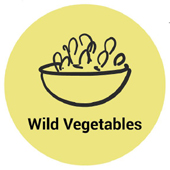Agriculture is one of India’s primary occupations. As per the 2011 census, about 54.6% of India’s population is engaged in agriculture and allied activities. As of 2014, the contribution of agriculture to the country’s GDP stands at 17.9%. Yet agriculture alone has been unable to be a viable source of livelihood for one-third of the farming households in the country. This is especially high amongst subsistence farmers with small or no land holdings. There is hence, a need to look at supplementary employment opportunities to improve livelihood of the rural population.
Wild foods are those that are naturally occurring in the environment. Wild edible plants like fruits, flowers, leaves, tubers, and roots are high in nutritional content, some of them even possessing medicinal properties. Over the years, wild foods have been used by indigenous tribes to meet their dietary and nutritional needs. These foods are not only consumed for their nutritional content but also due to food shortages, as they are abundant and freely available. Some of these wild vegetables are also sold by farmers in nearby towns and villages, providing them with a temporary source of income.
The present knowledge about wild foods remains scarce and has been declining overtime, with urban areas having very limited to no knowledge about the same. There has been an increasing demand for natural, organic produce by Indian consumers with the present organic food market in India being expected to grow three times by 2020.
Hence, given the demand for organic food, and the present availability, nutritional content and uniqueness of wild foods, it serves as a potential means to provide a source of livelihood for the rural poor. This project aims to look at the promulgation of wild vegetables as a means to generate livelihood for the rural population using Service Design.
Case Study Download:
• Service Design for Wild Vegetables as a Source of livelihood generation......
• Service Design for Wild Vegetables as a Source of livelihood generation_Report......


